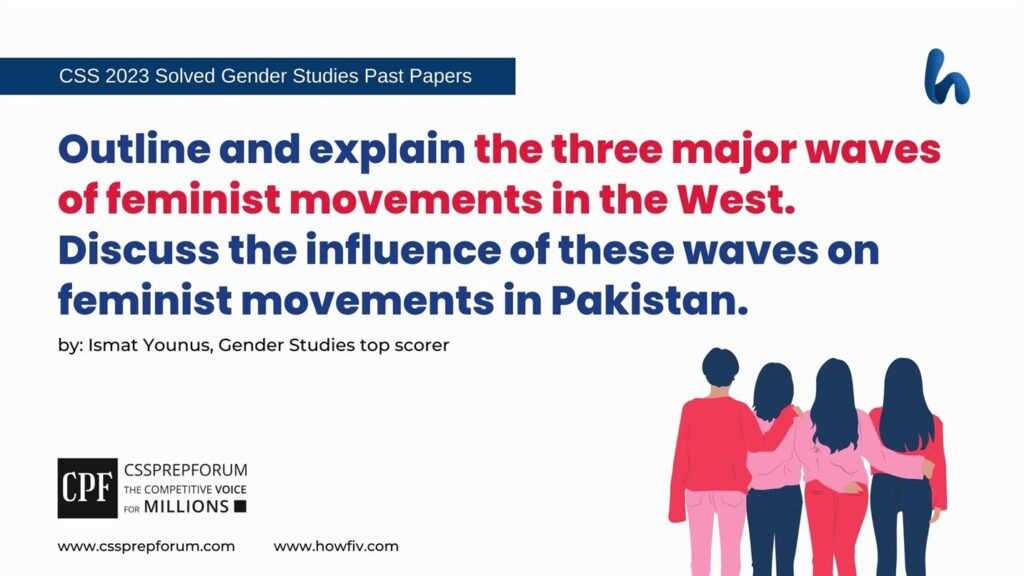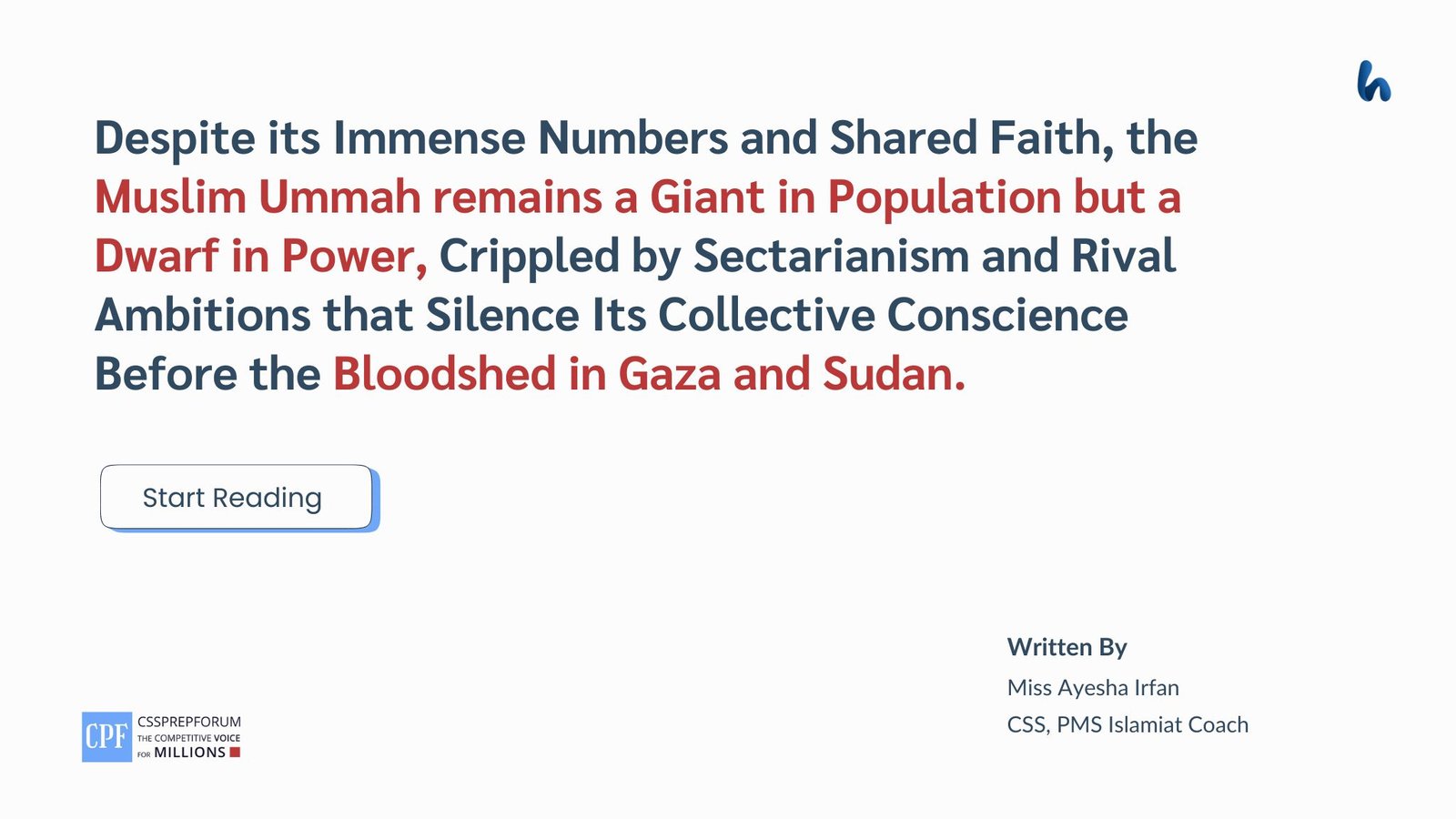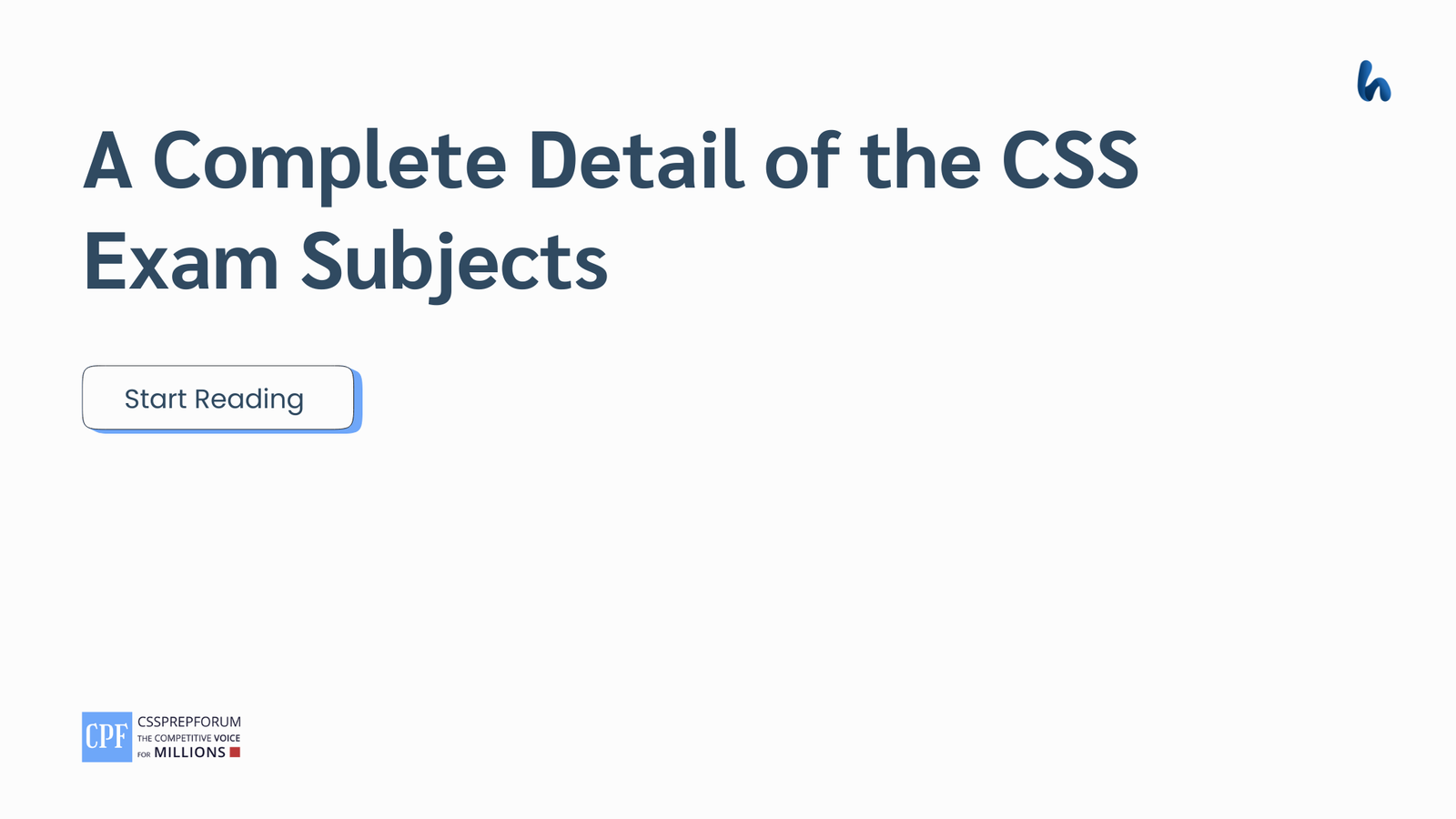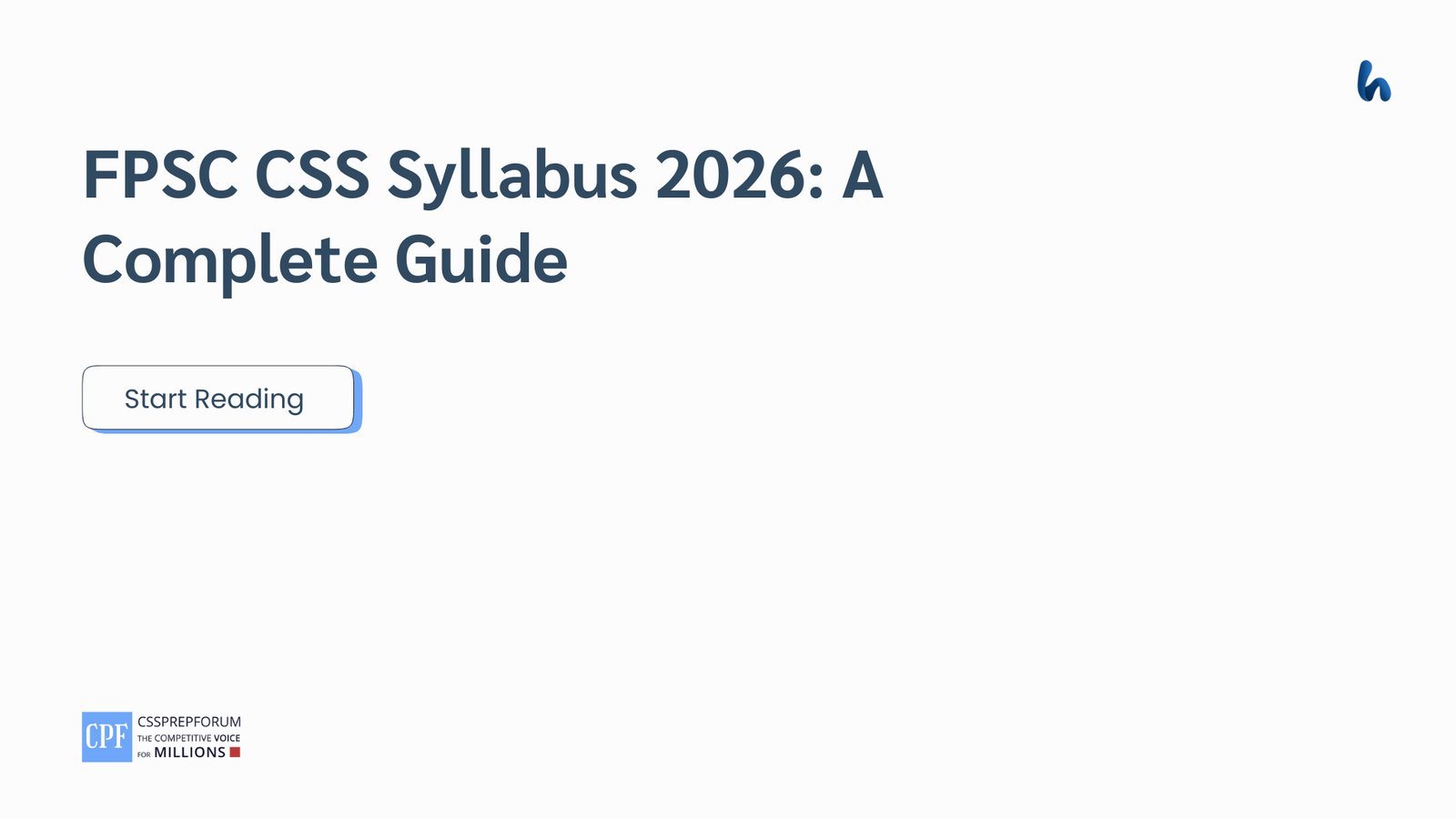CSS Solved Gender Studies Past Papers | Outline and explain the three major waves of feminist movements in the West. Discuss the influence of these waves on feminist movements in Pakistan.
The following question of Gender Studies is solved by Ismat Younus, the highest scorer in CSS Gender Studies. Moreover, the question is attempted on the same pattern, taught by Sir to his students, scoring the highest marks in compulsory subjects for years. This solved past paper question is uploaded to help aspirants understand how to crack a topic or question, how to write relevantly, what coherence is, and how to include and connect ideas, opinions, and suggestions to score the maximum

Question Breakdown:
In this question, the examiner seeks the explanation of the first wave, second wave, and third wave of feminism, so the student must give equal weightage to all the waves. First of all, introduce the topic and write a comprehensive introduction of the whole question. Then define the key terms and shed some light on the historical perspectives, objectives, efforts, and then the impacts of all these waves of feminism on Pakistani society. Hereafter, the student must conclude the question comprehensively.
Outline
1- Introduction
The first, second, and third waves of feminism represent the different periods during the 19th and 20th centuries’ struggle for political, economic, and social equality of women.
2- What is feminism?
“It is a belief in social, political and economic equality of different sexes, particularly of women.”
3- First wave of feminism
- Historical background of the first wave of feminism
“I do not wish women to have power over men; but over themselves.”(Mary Wollstonecraft)
- Objectives of the first wave of feminism
- ✓Cady Stanton’s demands in Seneca fall
- ✓Suffrage rights
- Efforts made for the achievement of goals
- ✓Langham palace circle
- ✓Speech of Sojourner Truth “Aren’t I A Woman?”
- ✓Women suffrage movement
- Role of the first wave of feminism in Pakistan
4- Second wave of feminism
- Historical background of the second wave of feminism
Second-wave feminism was a period of feminist activity that began in the early 1960s and lasted roughly two decades.
- Objectives of the first wave of feminism
- ✓Demanded the end of oppression
- ✓Suffrage rights
- ✓Reproduction rights
- Efforts made for the achievement of goals
- ✓National Organization for Women
- ✓The Civil Rights Movement
- Role of the second wave of feminism in Pakistan
- ✓Creation of APWA and WAF
5- Third wave of feminism
- Historical background of the third wave of feminism
- Objectives of the third wave of feminism
- ✓Major aim was to introduce the concept of intersectionality and make feminism transnational due to the prevalence of globalization
- Efforts made for the achievement of goals
- ✓4th world conference on women in Beijing
- Role of the third wave of feminism in Pakistan
- ✓Signatory of CEDAW 1996
6- Conclusion

Answer to the question
Introduction
The world has already witnessed three waves of feminism and now has been experiencing the fourth wave since 2012. The first wave of feminism began in the late 19th and early 20th century in western countries. The main target of it was to create opportunities for women. It focused on the achievement of women’s suffrage. Historically, it gained momentum from the book, “A Vindication of the Rights of Women “written by Marry Wollstonecraft. Later on, the Seneca Fall Convention of July 20, 1948, and the creation of the Langham palace circle substantiated the cause for women’s rights. The objective of this wave was to attain the suffrage right for the subjugated stratum of western society. And this objective was achieved through the efforts of the suffrage movement. The second wave roughly dating from the 1960s to the 1980s, involved an expansion of previous ideas and victories of first-wave feminism. The second wave pushed for equal opportunities in the workplace, home, and public sphere. It results in the creation of APWA and the Women Action Forum in Pakistan. The third wave of feminism emerged in the mid-1990s. It started in the era of globalization. As a result, it focused on the inclusion of all kinds of women who belonged to different races, ethnicities, and gender identities. The third wave surged by the effort of the United Nations’ fourth women’s conference in Beijing. The far-reaching impacts of these waves are eminent in Pakistani society. Pakistan’s legislation, due to these movements, has promulgated many acts and laws for the gender mainstreaming and emancipation of women in Pakistani society.
Define feminism
“It is a belief in social, political and economic equality of different sexes, particularly of women.”
First wave of feminism
- Historical background of the first wave of feminism
Simone de Beauvoir wrote that “the first time we see a woman take up her pen in defense of her sex” was Christine de Pizan, a French woman, in the 15th century. First-wave feminism refers to an extended period of feminist activity during the nineteenth century and early twentieth century in the United Kingdom and the United States. It was primarily based on gaining political power, particularly the right of women’s suffrage. In 1794, Marry Wollstonecraft realized that women’s role and their efforts in the French revolution had been neglected. Therefore, she wrote her book, “A Vindication of the Rights of Women “, to bring to light the struggle of women.
“I do not wish women to have power over men; but over themselves.”
(Mary Wollstonecraft)
- Objectives of the first wave of feminism
This phase revolved largely around gaining basic legal rights for women that today women cannot imagine reality without. Women were confined to their households and didn’t retain any control there as well. Unmarried women were seen as the property of their fathers, and married women as the property of their husbands. They couldn’t file for divorce or be granted custody of their children. Cady Stanton, as a result, asked for four different rights for women
- The right of suffrage
- The right to education
- The right to own property
- The right of employment
Thus, these were the major rights asked by feminist activists in the wake of the first wave of the movement.
- Efforts made for the achievement of goals
“It was we, the people; not we the white male citizen… who formed the union.”
(Susan B.Anthony)
The first wave was connected with the abolitionist movement in the USA at the time. Both movements aimed at social reformation and liberation from oppression. The former from the patriarchy and the latter from racial bias. The wave is often demarcated as officially beginning with the signing of the ‘Declaration of Sentiments’ at the Seneca Falls Convention, the first-ever women’s rights convention. Suffrage, the right of women to vote in elections, became the goal of the movement with the formation of the American Equal Rights Association in 1866. When this organization collapsed, the National Women Suffrage Association (NWSA) was formed in early 1869. In the 1850s, a group named Langham Palace Group campaigned for the equal rights of women in Britain. Similarly, in 1951, Sojourner Truth gave a speech titled,” Ain’t I A Woman?” in which she talked about how women are as capable as men.
- ✓ Women Suffrage Movement
The women’s suffrage movement was a decades-long fight to win the right to vote for women in the United States. After so many efforts the Nineteenth Amendment was ratified by all states. The Amendment declared, “The right of citizens of the United States to vote shall not be denied or abridged by the United States or by any State on account of sex.”
- Role of the first wave of feminism in Pakistan
The first wave of feminism didn’t impart any role in Pakistan because Pakistan was not independent at that time. However, women in Pakistan have started asking for social, political, and economic rights right after the country’s inception.
Second wave of feminism
- Historical background of the second wave of feminism
Second-wave feminism was a period of feminist activity that began in the early 1960s and lasted roughly two decades. In 1963, Betty Friedan published The Feminine Mystique, which argued that women were chafing against the confines of their roles as wives and mothers. Inspired by the civil rights movement and protests against the Vietnam War, second-wave feminists called for a reevaluation of traditional gender roles in society and an end to sexist discrimination.
- Objectives of the second wave of feminism
Much like the first wave that developed during a period of social reform, the second wave also took place amidst other social and political movements.
- ✓ The end of oppression
Second-wave feminism focused on oppression. Based on this common experience, women constituted united groups to end this curse of oppression and showed sisterhood. The second-wave feminist movement also took a strong stance against physical violence and sexual assault in both the home and the workplace. - ✓Reproduction rights
Another demarcation of the second wave was through legislative measures. The Food and Drug Administration approved an oral contraceptive pill, made available in 1961 that was an important step towards letting women develop careers instead of being forced into family life. A report released by the commission on gender inequality recommended paid maternity leave, access to education, and good childcare to help women.
- Efforts made for the achievement of goals
In 1963, writer and feminist Betty Friedan published The Feminine Mystique, a nonfiction book in which she contested the post-World War II belief that it was women’s destiny to marry and bear children. Friedan’s book was a best-seller and began to raise the consciousness of many women who agreed that homemaking in the suburbs sapped them of their individualism and left them unsatisfied.
- ✓ National Organization for Women (NOW)
In 1966, the National Organization for Women (NOW), formed and proceeded to set an agenda for the feminist movement. Framed by a statement of purpose written by Friedan, the agenda began by proclaiming NOW’s goal to make possible women’s participation in all aspects of American life and to gain for them all the rights enjoyed by men.
- ✓The Civil Right Movement
When the second wave of feminism began, the Civil Rights Movement was already in full swing. After emancipation, African American men and women still had to fight against racism, violence, and segregation to exercise their basic human rights.
- Role of the second wave of feminism in Pakistan
Inspired by the second wave of feminism in the 1960s, Pakistani women too embarked on a journey of ameliorating their socio-economic conditions. They argued that having voting rights did not guarantee the end of their oppression at the hands of men. The initial influence of the feminist movement during the second wave in Pakistan included the issuance of the Muslim Family Law Ordinance, in 1961. The law aimed to regulate family affairs by protecting women’s rights. In the subsequent year, another law, the West Pakistan Muslim Personal Law (Shariat) Act, 1962 was introduced in the country. It allowed Pakistani women to inherit all forms of property.
- ✓ Creation of APWA
APWA was founded in 1949 by Begum Ra’ana Liaquat Ali Khan, a famous activist for women’s rights, who had said that the role of women is no less important than that of men. Initially, APWA was formed to handle the refugee crisis in the newly independent Pakistan after the 1947 partition of India. Later on, it dealt with the promotion of moral, social, and economic welfare of the women of Pakistan in the wake of the second wave of feminism. - ✓Creation of Women Action Forum
Under General Zia UL Haq’s rule and Islamization of the nation-state, a group of women met in Shirkat Gah Karachi in 1981 and formed the Women Action Forum (WAF) to challenge and protest the Hudood Ordinances of 1979. WAF was the face of feminism in Pakistan in the 80s, with picketing, demonstrations, and processions.
Third wave of feminism
While the advances of second-wave feminism had undoubtedly achieved more equality and rights for women, the third wave of feminism emerged in the 1990s focused on tackling problems that still existed, including sexual harassment in the workplace and a shortage of women in positions of power.
- Historical background of the third wave of feminism
“We have to free half of the human race, the women so that they can help to free the other half.”
(Pankhurst)
The third wave of feminism emerged in the mid-1990s accompanied by globalization. The third wave of feminism was more pronounced about the rights of women and didn’t limit to a single country. It was founded by Rebecca walker to support young activists in 1992. It included women from all nations, colors, races, ethnicities, and different gender identities. Tran’s feminism was brought more into the mainstream in the Third Wave.
- Objectives of the third wave of feminism
Following were the objectives of the third wave of feminism
- It focused on reproductive rights for women.
- It opposed the derogatory labels
- It emphasized intersectionality.
- It made the trend of feminism transnational.
- Efforts made for the achievement of goals
In the summer of 1992, Walker and Shannon Liss started the Third Wave Direct Action Corporation. In 1997, the Third Wave Direct Action Corporation became the Third Wave Foundation. The foundation created grants for women’s projects, abortions, scholarships, and creating young women’s reproductive rights organizations. Similarly, the 4th world conference on women held in Beijing started a new chapter of equality in 1995. It made a shift from women to gender and reevaluated the entire structure of society.
- Role of the third wave of feminism in Pakistan
“No nation can rise to the height of glory your women are side by side with you”
(Muhammad Ali Jinnah)
The aforementioned statement is the depiction of Quaid’s notion about women’s status in Pakistan. The feminist activism as a result of the conscious raising of the third wave of feminism resulted in the mushrooming of NGOs for women’s rights. Similarly. Many laws, for instance, the Women’s Protection Act, of 2006, the Protection Against Harassment of Women at the Workplace Act, of 2010, and so on, were promulgated to secure women and other genders from all kinds of violence. Moreover, Pakistan has also become a signatory of CEDAW (Convention on Elimination of Discrimination Against Women). Some notions consider these waves against the tenets of Islam. However, a moderate approach is the need of the hour for Pakistani society.
Conclusion
Since the mid-19th century, the world has called for greater political, economic, and cultural freedom and equality for women. The concept of the “waves of feminism” first surfaced in the late 19th century which demanded an egalitarian society and suffrage rights for women. Many feminist activists took strict measures to emancipate women in society. They demanded equal voting rights and equal job opportunities through the Seneca fall convention, the Langham palace group, and the suffrage rights movement for the creation of equality between men and women. In the wake of the second wave of the feminist movement, women called for the end of oppression and seek reproduction rights. For this, they held many demonstrations and with the help of the National Organization for Women (NOW), they put forward their agenda. Lately, during the third wave of feminism, the outlook of the world has changed from national to transnational. Resultantly, the third wave of feminism became more inclusive and aimed to encompass all genders instead of just women. The United Nations conference on women has played an imperative role in this regard. All these waves of feminism have imparted significant changes in Pakistan and created a more viable environment for gender mainstreaming.
CSS Solved Past Papers’ Essays
Looking for the last ten years of CSS and PMS Solved Essays and want to know how Sir Kazim’s students write and score the highest marks in the essays’ papers? Then, click on the CSS Solved Essays to start reading them.
CSS Solved Essays

CSS Solved General Science & Ability Past Papers
Want to read the last ten years’ General Science & Ability Solved Past Papers to learn how to attempt them and to score high? Let’s click on the link below to read them all freely. All past papers have been solved by Miss Iqra Ali & Dr Nishat Baloch, Pakistan’s top CSS GSA coach having the highest score of their students.
General Science & Ability Solved Past Papers
CSS Solved Pakistan Affairs Past Papers
Want to read CSS Pakistan Affairs Solved Past Papers and learn how to attempt them to score high? Let’s click on the link below to read them all freely. All past papers’ questions have been attempted by Sir Kazim’s students, who scored the highest in the subject.
CSS Solved Pakistan Affairs
CSS Solved International Relations’ Past Papers
Have you opted for International Relations in the CSS examination and want to score above 150? Then, click on the CSS Solved International Relations’ Past Papers by Miss Abeera Fatima, the top IR scorer and the best IR coach in Pakistan.
CSS Solved International Relations Past Papers
Articles Might Interest You!
The following are some of the most important articles for CSS and PMS aspirants. Click on any to start reading.












